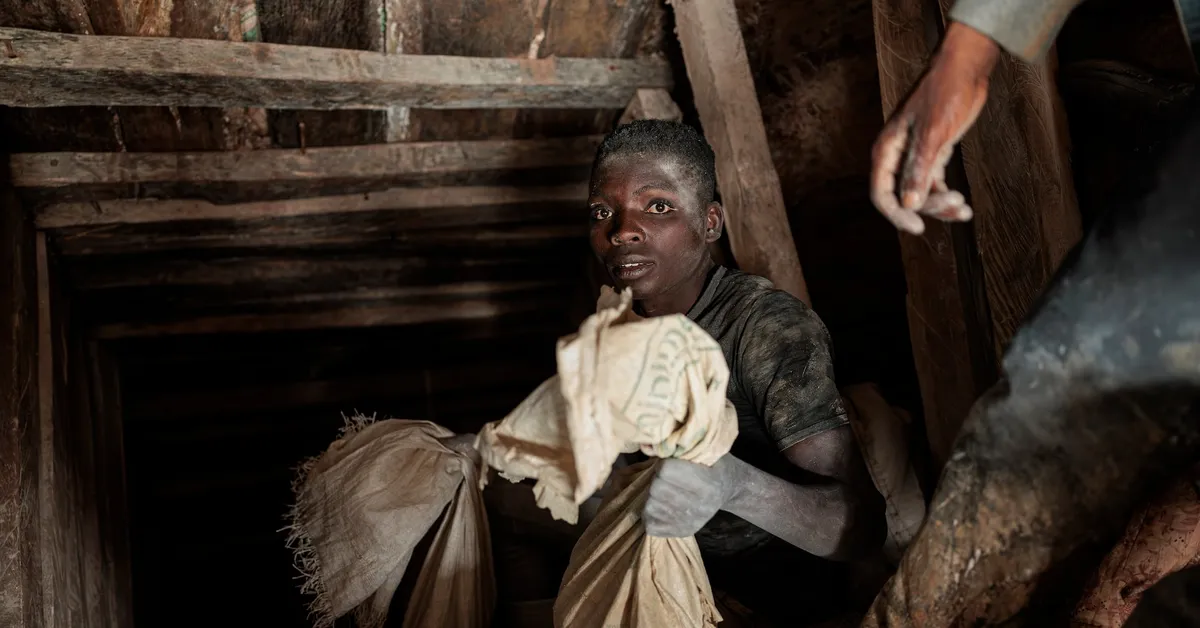
In the picturesque hills surrounding the town of Rubaya, Democratic Republic of Congo, a group of men clad in rubber boots diligently transport sacks filled with crushed rocks. These laborers are engaged in the arduous task of hauling coltan ore, a precious mineral that powers the modern world. The coltan will soon be loaded onto motorbikes and shipped across thousands of kilometers to Asia, where it will be processed into tantalum—a heat-resistant metal highly sought after by manufacturers of mobile phones, computers, aerospace components, and gas turbines.
Rubaya is a significant player in the global coltan market, producing approximately 15% of the world's supply. Unfortunately, this wealth is primarily extracted by impoverished locals, who earn a mere few dollars each day. Control over the Rubaya mining site represents a critical prize in an enduring conflict that has plagued the region. In April 2024, the area fell into the hands of M23, a rebel group accused by the United Nations of exploiting Rubaya's resources to finance its insurgency, allegedly supported by the government of neighboring Rwanda.
The M23 rebels, heavily armed and determined, aim to unseat the government in Kinshasa while ensuring the safety of the Congolese Tutsi minority. This year, they have expanded their control over even more mineral-rich territories in the eastern Democratic Republic of Congo. As the spotlight shines on this region, M23 and the DRC are set to sign a peace deal in Doha, Qatar, this month, with the United States mediating parallel discussions between Congo and Rwanda. The U.S. has hinted at substantial investments—potentially worth billions—if hostilities come to an end.
Recently, the U.S. Treasury imposed sanctions on individuals involved in mineral smuggling in Congo, including the pro-government militia PARECO-FF, which controlled the Rubaya mining site before M23's takeover. While PARECO-FF could not be reached for comment, a senior U.S. official explained that M23 has been under U.S. sanctions since 2013 for its role in fueling regional conflict.
Rwanda's government has consistently denied allegations of trafficking in looted coltan or supporting M23. However, the ruling party, predominantly Tutsi, shares concerns with M23 over rival Hutu groups in eastern Congo. A recent U.N. report noted that Rwanda has stationed between 1,000 to 1,500 troops in rebel-controlled areas of Congo. M23 now holds strategic cities like Goma and Bukavu, facilitating the illegal transport of Congolese minerals to Rwanda.
Despite accusations from Congolese officials that Rwanda is exacerbating the conflict to exploit Congo’s resources, a December U.N. report revealed that M23 has established a parallel administration overseeing mining operations, trade, and taxation in Rubaya. The rebels reportedly collect a 15% tax on mineral traders, generating an estimated $800,000 monthly from coltan mining activities.
Accessing Rubaya's complex mining site is not an easy task. Journalists from Reuters encountered significant challenges navigating muddy roads, ultimately resorting to a 5-kilometer trek on foot before hitching rides on motorcycles to reach the pits. Each day, before dawn, thousands of miners descend upon the site, working grueling 12-hour shifts in tunnels that can reach depths of 15 meters (49 feet).
Once the ore is extracted, porters carry the sacks to shallow basins, where laborers—including women and children—wash the ore to separate it from sand and debris. Throughout their visit, the Reuters team was accompanied by unarmed M23 personnel, who monitored the amount of ore collected by each porter.
One miner, Pascal Mugisha Nsabimana, expressed that working under M23 is preferable to the previous supervision of the Congolese military. Under M23's control, his daily earnings have tripled to approximately 15,000 Congolese francs (around $5.15). Following M23's takeover, smugglers initially used motorcycles to transport coltan into Rwanda, but the rebels have since streamlined operations, allowing larger vehicles to carry significant quantities of ore more efficiently across the border.
Despite the increased efficiency in mining operations, human rights advocates continue to raise alarms about the conditions in Rubaya. Reports of child labor are prevalent, with young boys entering shafts to extract ore while girls assist with washing and drying the coltan. Gregory Mthembu-Salter, a former U.N. expert, lamented the failure of initiatives aimed at improving the region’s supply chain and preventing human rights abuses, stating, “Here we are, 15 years later, and the same thing is happening.”
As peace talks continue, U.S. investors are eyeing Rubaya's mineral wealth. The region is rich in various resources, including cobalt, gold, copper, lithium, and diamonds. Gentry Beach, a Texas hedge fund manager, has been linked to negotiations for rights to the Rubaya mine, proposing a deal where the Congolese government retains a 30% stake.
However, some U.S. lawmakers have expressed concerns about the administration's transparency in these negotiations, particularly regarding potential conflicts of interest. The White House has stated that the agreement between Congo and Rwanda could lead to lasting peace and stability, although the situation remains precarious.
The ongoing peace initiatives are critical for ensuring safety and investment in Rubaya. The U.S.-brokered accord does not include M23, which is pursuing separate mediation efforts in Doha. The success of these talks is vital for lasting peace in the region and the potential development of Rubaya's mineral wealth. However, skepticism remains among diplomats and analysts regarding the feasibility of achieving a quick resolution.
The challenges in neutralizing Hutu militias like the FDLR complicate the situation, as does the need to transform Rubaya’s artisanal mining practices into modern operations. As peace negotiations unfold, the future of Rubaya and its invaluable resources hangs in the balance, awaiting a resolution that can benefit both the local population and international investors.